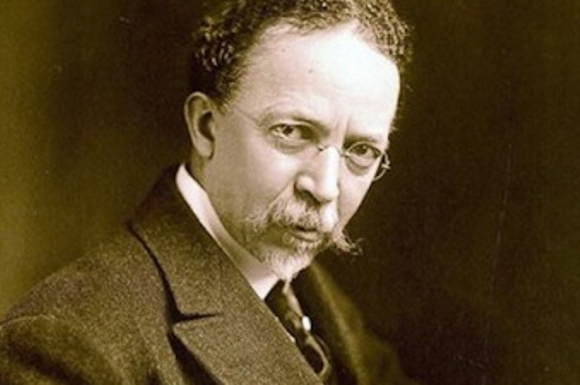
Biography
Henry Ossawa Tanner (1859 – 1937) was an American artist and teacher who is widely recognized as the first African American to achieve international acclaim as a painter. Working primarily from two locations in France, he is most well-known for his transformative religious genre paintings.
Born in Pittsburgh, Pennsylvania, Tanner was the oldest of nine children. His father, Benjamin Tucker Tanner, was a college-educated bishop of the African Methodist Episcopal Church — the first independent black denomination in the United States. His mother, Sarah Elizabeth Miller, was born a slave and helped organize one of the first missionary organizations for Black women. Tanner’s middle name, Ossawa, was derived from the Kansas town of Osawatomie where abolitionist John Brown began advocating against slavery.[1] Tanner was about 13 years old when, while on a walk with his father, he saw a landscape painter working at a park near his home. From that random experience, Tanner knew he wanted to be an artist.[2] However, Tanner’s father saw art as a hobby and, when Tanner wasn’t interested in entering the church upon graduating, arranged for his son to work at a family friend’s flour mill. The work there proved too arduous for Tanner, and he became ill and unhappy after which his father finally relented and supported his career as an artist.[3]
In 1880 when he was 21, Tanner enrolled in Philadelphia’s prestigious Pennsylvania Academy of Fine Arts as its first African American student. He studied with Thomas Eakins — an American realist painter, photographer, sculptor, and educator — who advocated new approaches to the artistic study of human anatomy, and greatly influenced Tanner’s early style. However, Tanner left the Academy before graduating in order to establish a photography gallery in Atlanta, Georgia where he attempted to earn a living selling his art, making photographs, and teaching art classes at Clark College. While in Atlanta, Tanner met Bishop and Mrs. Joseph Crane Hartzell who were to become his primary patrons over the next several years. With their support, Tanner sailed for Rome in 1891, while also visiting Paris. He was so impressed with the art community there that he decided to stay. He also felt more comfortable in Parisian society, which at the time, did not discriminate as much against Blacks.
In Paris, Tanner enrolled in the Académie Julian where he studied under painters Jean Paul Laurens and Jean Joseph Benjamin-Constant. Soon after, he painted his most important works depicting African American subjects, The Banjo Lesson (1893) and The Thankful Poor (1894).[4] After 1895, Tanner turned his attention to painting religious subjects and experimented with different colors and light to achieve the desired results of portraying the intensity and fire of religious moments. His early works from this period include The Resurrection of Lazarus (1896) and The Annunciation (1898).[5]
In 1898, Tanner met Jessie Macauley Olssen, an American singer of Swedish descent who was 15 years his junior and was vacationing with her family in France. They married in 1899, and four years later they had a son. The family took up residence in Paris, buying a home in Normandy where they spent many summers near an artist colony in which Tanner participated.[6]
Tanner made his last trip to the United States to promote his work in 1923. This was the same year that he was elected Chevalier of Legion of Honor by the French government.[7] Shortly thereafter, his wife became ill and died on September 8, 1925. During the final decades of his career, Tanner enjoyed consistent acclaim. In 1900, his 1895 painting, Daniel in the Lion’s Den, was awarded a silver medal at the Universal Exposition in Paris. The following year, it received a silver medal at the Pan American exhibition in Buffalo, New York. In 1927 he became a full academician of New York City’s National Academy of Design, the first African American to receive that honor. Though he wasn’t part of the Harlem Renaissance, many Black artists of that era took inspiration in what Tanner achieved during his lifetime. He died peacefully on May 25, 1937 at his home in Paris.[8]
[1] The Art Story website. “Henry Ossawa Tanner, American Painter.” Accessed on May 11, 2022. https://www.theartstory.org/artist/tanner-henry-ossawa/#article
[2] The Smithsonian American Art Museum Website. “Henry Ossawa Tanner.” Accessed on May 11, 2022. https://americanart.si.edu/artist/henry-ossawa-tanner-4742
[3] The Art Story website. “Henry Ossawa Tanner, American Painter.” Accessed on May 11, 2022. https://www.theartstory.org/artist/tanner-henry-ossawa/#article
[4] The Smithsonian American Art Museum Website. “Henry Ossawa Tanner.” Accessed on May 11, 2022. https://americanart.si.edu/artist/henry-ossawa-tanner-4742
[5] Wikipedia’s entry on Henry Ossawa Tanner. Last updated May 4, 2022. Accessed on May 11, 2022. https://en.wikipedia.org/wiki/Henry_Ossawa_Tanner
[6] The Art Story website. “Henry Ossawa Tanner, American Painter.” Accessed on May 11, 2022. https://www.theartstory.org/artist/tanner-henry-ossawa/#article
[7] Ibid.
[8] The Smithsonian American Art Museum Website. “Henry Ossawa Tanner.” Accessed on May 11, 2022. https://americanart.si.edu/artist/henry-ossawa-tanner-4742
This artist's biography was written by Phyllis Geraghty, a writer with professional experience in the public relations, education, health, and non-profit sectors.
Illustrations by Henry Ossawa Tanner
Additional Resources
Bibliography
Bedell, Rebecca Bailey. Moved to Tears: Rethinking the Art of the Sentimental in the United States. Princeton: Princeton University Press, 2018.
Etinde-Crompton, Charlotte and Samuel Willard Crompton. Henry Ossawa Tanner: Landscape Painter and Expatriate. New York: Enslow Publishing, 2020.
Mosby, Dewey F., Nelson-Atkins Museum of Art, Dallas Museum of Art and Terra Museum of American Art. Across Continents and Cultures: The Art and Life of Henry Ossawa Tanner. Kansas City: Nelson-Atkins Museum of Art, 1995.
Tanner, Henry O. and Anna O. Marley. Henry Ossawa Tanner: Modern Spirit. Berkeley: University of California Press, 2012.
Woods, Naurice Frank. Henry Ossawa Tanner: Art, Faith, Race, and Legacy. New York: Routledge, 2018.






















